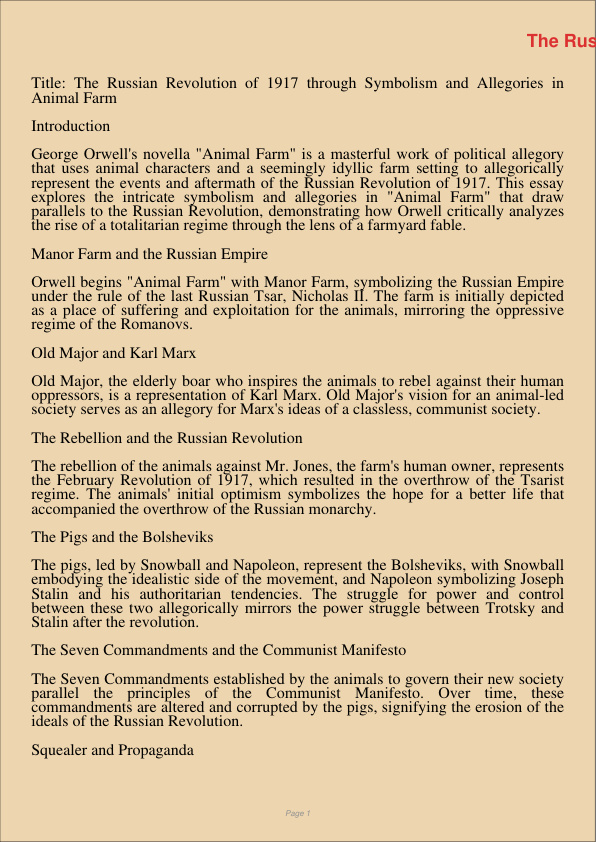
Title: The Russian Revolution of 1917 through Symbolism and Allegories in Animal Farm
Introduction
George Orwell’s novella “Animal Farm” is a masterful work of political allegory that uses animal characters and a seemingly idyllic farm setting to allegorically represent the events and aftermath of the Russian Revolution of 1917. This essay explores the intricate symbolism and allegories in “Animal Farm” that draw parallels to the Russian Revolution, demonstrating how Orwell critically analyzes the rise of a totalitarian regime through the lens of a farmyard fable.
Manor Farm and the Russian Empire
Orwell begins “Animal Farm” with Manor Farm, symbolizing the Russian Empire under the rule of the last Russian Tsar, Nicholas II. The farm is initially depicted as a place of suffering and exploitation for the animals, mirroring the oppressive regime of the Romanovs.
Old Major and Karl Marx
Old Major, the elderly boar who inspires the animals to rebel against their human oppressors, is a representation of Karl Marx. Old Major’s vision for an animal-led society serves as an allegory for Marx’s ideas of a classless, communist society.
The Rebellion and the Russian Revolution
The rebellion of the animals against Mr. Jones, the farm’s human owner, represents the February Revolution of 1917, which resulted in the overthrow of the Tsarist regime. The animals’ initial optimism symbolizes the hope for a better life that accompanied the overthrow of the Russian monarchy.
The Pigs and the Bolsheviks
The pigs, led by Snowball and Napoleon, represent the Bolsheviks, with Snowball embodying the idealistic side of the movement, and Napoleon symbolizing Joseph Stalin and his authoritarian tendencies. The struggle for power and control between these two allegorically mirrors the power struggle between Trotsky and Stalin after the revolution.
The Seven Commandments and the Communist Manifesto
The Seven Commandments established by the animals to govern their new society parallel the principles of the Communist Manifesto. Over time, these commandments are altered and corrupted by the pigs, signifying the erosion of the ideals of the Russian Revolution.
Squealer and Propaganda
Squealer, the eloquent and persuasive pig, is an allegory for propaganda in the Soviet Union. He distorts the truth and manipulates language to keep the other animals in check and justify the pigs’ actions, reflecting how propaganda was used to control the narrative in Stalin’s regime.
Boxer and the Working Class
Boxer, the loyal and hardworking horse, represents the working class in both the Soviet Union and the Russian Revolution. His eventual betrayal and fate illustrate how the proletariat was exploited and ultimately discarded by the ruling class.
The Farm’s Transformation and the Soviet State
As Animal Farm transforms from an idealistic society to a dystopian dictatorship run by the pigs, it mirrors the transformation of the Soviet state from the early days of the Russian Revolution to the authoritarian regime of Joseph Stalin.
Conclusion
George Orwell’s “Animal Farm” is a brilliant and scathing allegory of the Russian Revolution of 1917 and its aftermath. Through the clever use of animal characters and a seemingly simple farm setting, Orwell paints a stark picture of how a noble revolutionary movement can devolve into tyranny and oppression. The novel remains a powerful critique of totalitarianism, propaganda, and the corruption of revolutionary ideals, and it continues to serve as a poignant warning about the dangers of political manipulation and the erosion of democratic principles.
「真诚赞赏,手留余香」
真诚赞赏,手留余香
使用微信扫描二维码完成支付
